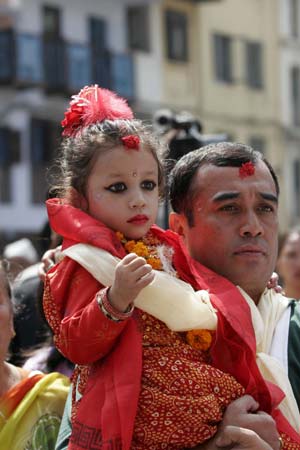Hindu and Buddhist priests chanted sacred hymns and cascaded flowers and grains of rice over a 3-year-old girl who was appointed a living goddess in Nepal on Tuesday.
Wrapped in red silk and adorned with red flowers in her hair, Matani Shakya received approval from the priests and President Ram Baran Yadav in a centuries-old tradition with deep ties to Nepal's monarchy, which was abolished in May.

|
|
The new Living Goddess Kumari arrives at Kumari Gahar in Kathmandu, Nepal, Oct. 7, 2008. Three-year-old Matina Shakya took her seat as the Living Goddess at Kumari Ghar on Tuesday. [Xinhua]
|
The new "kumari" or living goddess, was carried from her parents' home to an ancient palatial temple in the heart of the Nepali capital, Katmandu, where she will live until she reaches puberty and loses her divine status.
She will be worshipped by Hindus and Buddhists as an incarnation of the powerful Hindu deity Taleju.
A panel of judges conducted a series of ancient ceremonies to select the goddess from several 2- to 4-year-old girls who are all members of the impoverished Shakya goldsmith caste.
The judges read the candidates' horoscopes and check each one for physical imperfections. The living goddess must have perfect hair, eyes, teeth and skin with no scars, and should not be afraid of the dark.
As a final test, the living goddess must spend a night alone in a room among the heads of ritually slaughtered goats and buffaloes without showing fear.
Having passed all the tests, the child will stay in almost complete isolation at the temple, and will be allowed to return to her family only at the onset of menstruation when a new goddess will be named to replace her.
"I feel a bit sad, but since my child has become a living goddess I feel proud," said her father Pratap Man Shakya.
Matani Shakya replaces Sajani Shakya, who sparked a public debate about the role of the goddesses. Sajani was temporarily stripped of her revered status in July last year when she traveled to the United States to promote a documentary about the living goddesses.
Officials removed her title while she was overseas because tradition bars living goddesses from leaving the homeland. Popular support for Sajani apparently forced them to reverse the decision and reinstate her. On return to Nepal, Sajani was met by hundreds of supporters and followers.
She was retired in March at the age of 11, nearly a year after the controversy. Priests said her retirement had nothing to do with it and was because she had "come of age."
During their time as a goddesses, they always wear red, pin up their hair in topknots, and have a "third eye" painted on their foreheads.
Devotees touch the girls' feet with their foreheads, the highest sign of respect among Hindus in Nepal. During religious festivals the goddesses are wheeled around on a chariot pulled by devotees.
Critics say the tradition violates both international and Nepalese laws on child rights. The girls often struggle to readjust to normal lives after they return home.
Nepalese folklore holds that men who marry a former kumari will die young, and so many girls remain unmarried and face a life of hardship.